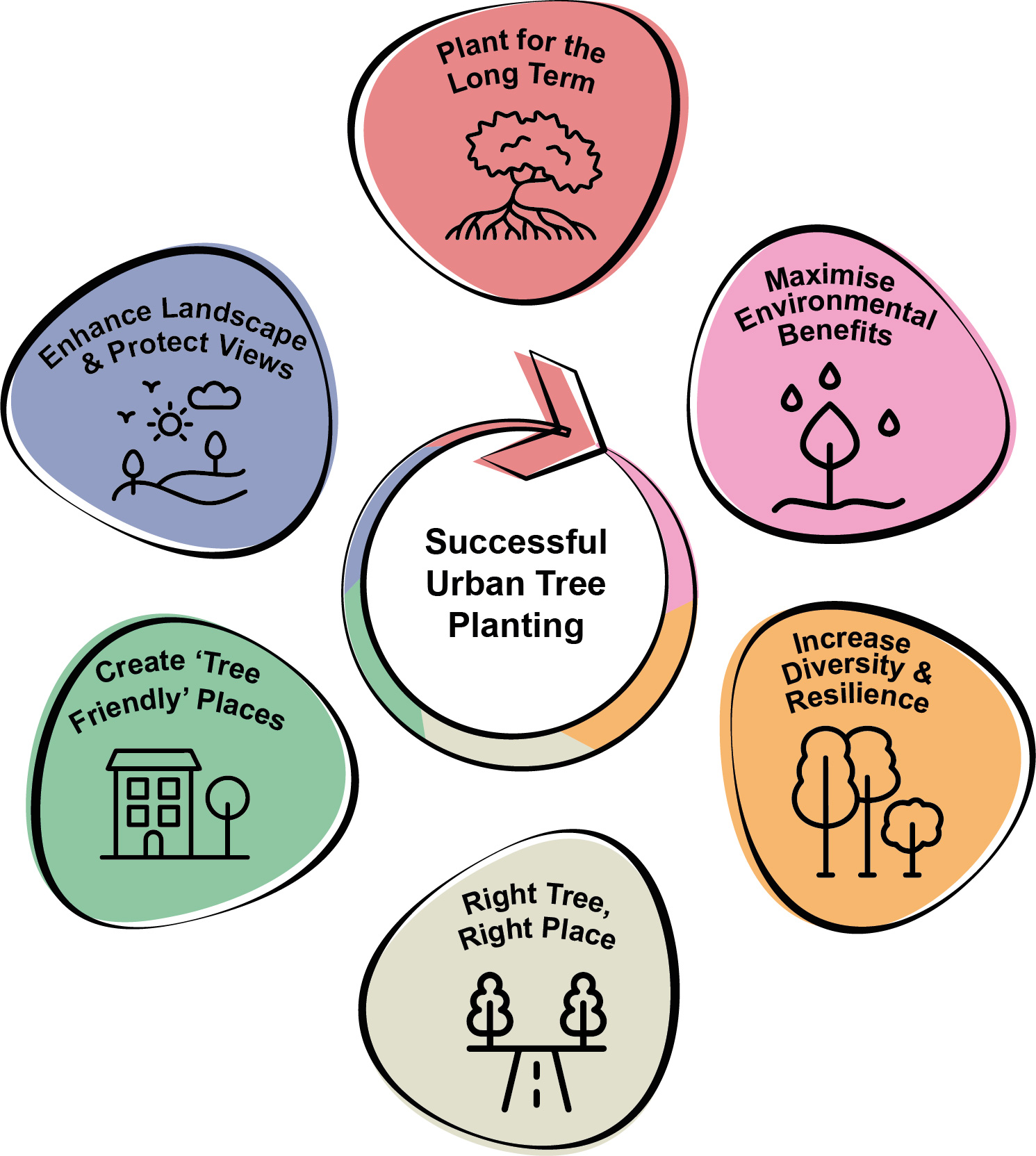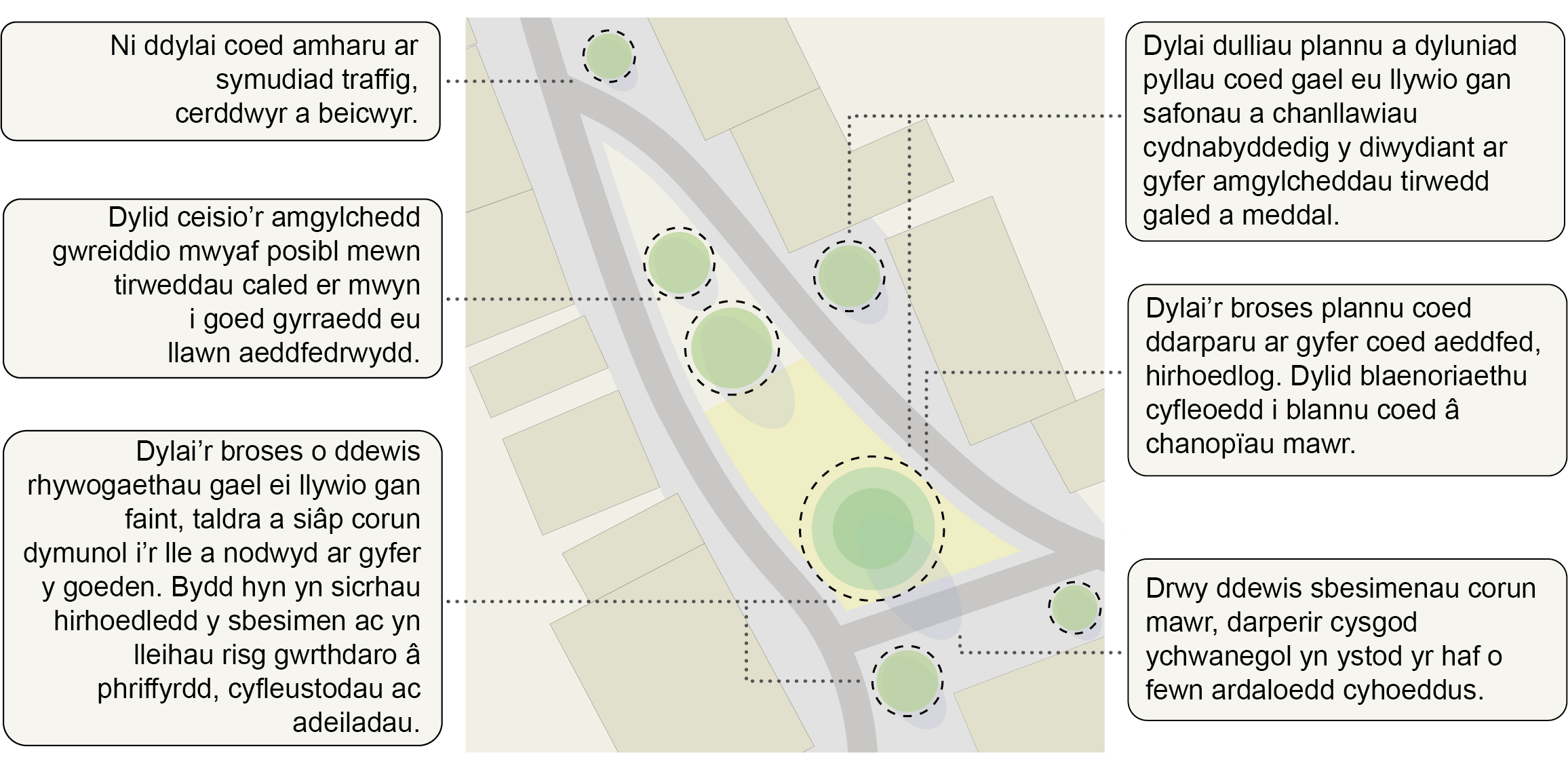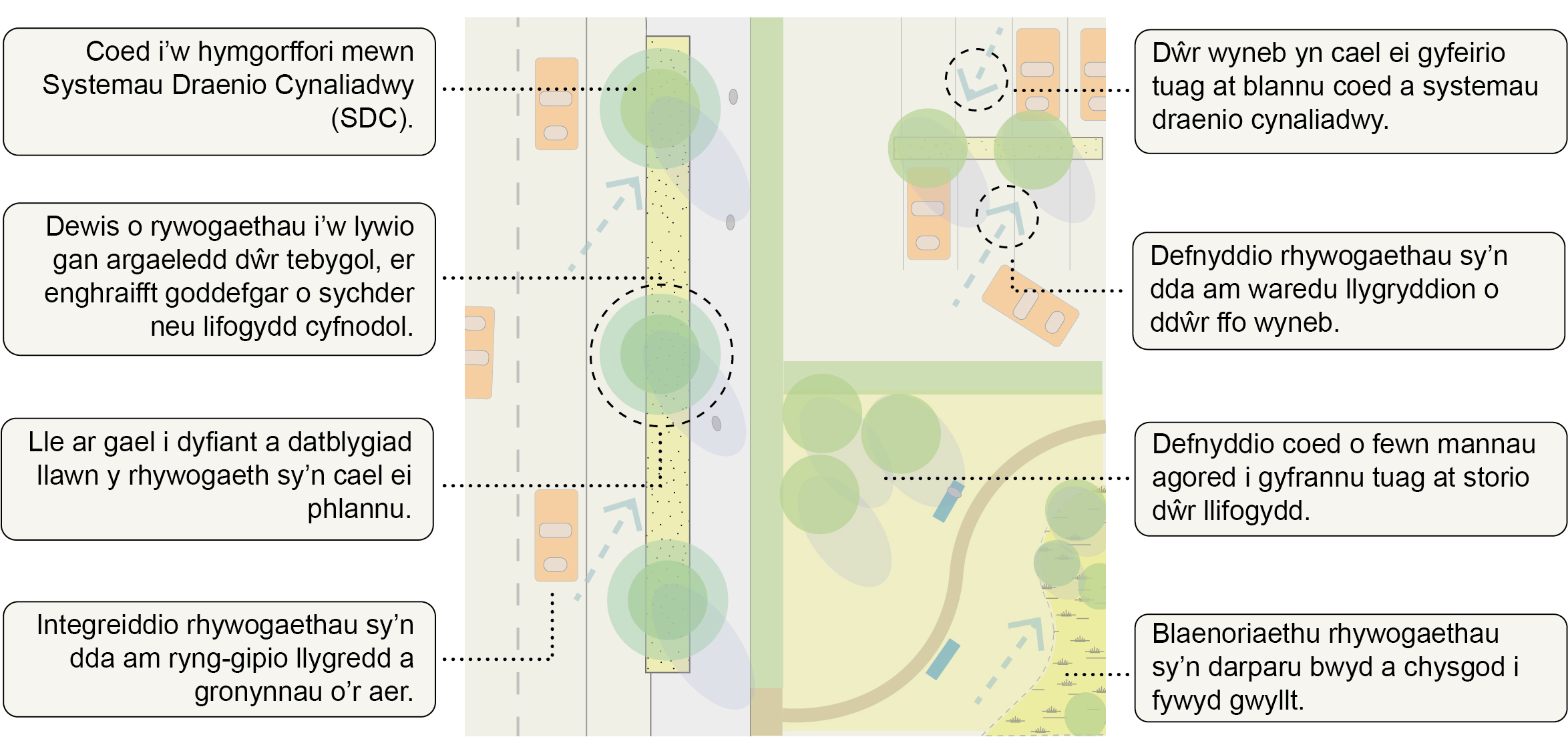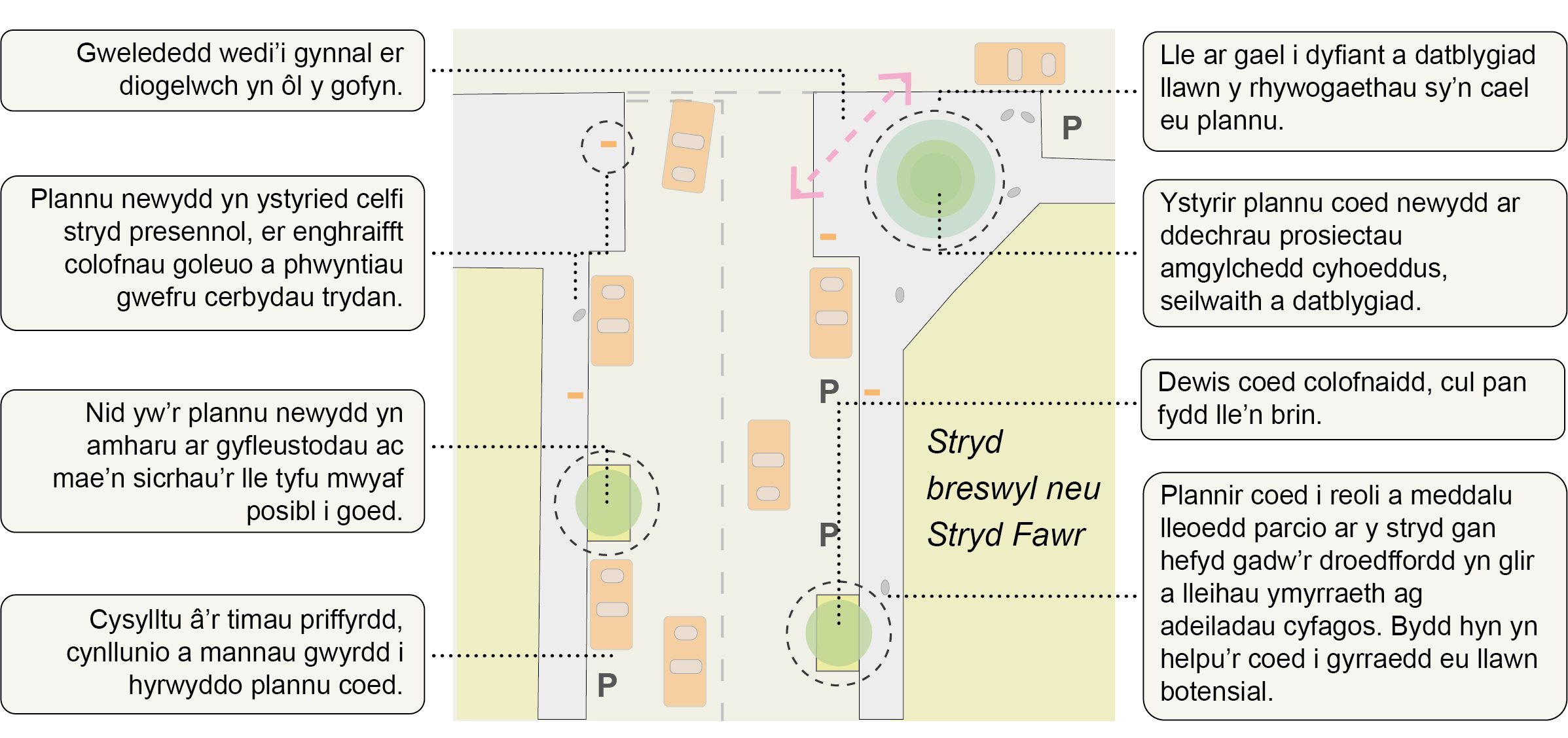Page Contents:
Plant for the long term
Maximise environmental benefits
Increase diversity and resilience
Right tree, right place
Create ‘tree friendly’ places
Enhance landscape and protect views
Overarching Principles
2.1 The following section sets out a range of overarching principles that will inform all tree planting within the 11 settlements. The overarching principles are supported by a set of sub-principles that apply to each settlement and strategic tree planting zones. These have been developed to ensure all future urban tree planting helps to deliver the vision and objectives for green Infrastructure (GI) in Pembrokeshire.
2.2 These have been informed by the baseline review for the study (including pressures and drivers for each settlement), site visits and consultation with stakeholders. The urban tree planting principles have also been developed to ensure alignment with existing guidance, including the Pembrokeshire Coast National Park Authority Tree and Woodland guidance (supplementary planning guidance to Pembrokeshire coast national park local development plan 2 – draft approved for public consultation). This document is due to be formally adopted by Pembrokeshire coast national park authority (PCNPA) (following a report of consultations) in 2023.
2.3 The overarching principles recognise that trees can provide multiple benefits for people, biodiversity and the wider environment. Trees that are able to reach full maturity, and trees with large canopies, provide greater benefits. In order to deliver healthy, mature trees, new urban tree planting must:
- Be well selected, planted and maintained.
- Have sufficient rooting space with uncompacted, fertile soil; and
- Have physical space to reach full maturity, without excessive pruning requirements.
2.4 The overarching principles also acknowledge that trees may potentially have disbenefits, which can be avoided with good planning and tree selection.
2.5 The overarching principles are set out under several headings. These are divided into those primarily relating to the design stage of a project, and those primarily relating to the delivery stage of the project.
Figure 2.1: Overarching Principles for Successful Tree Planting
Plant for the long term
Design
1a. Tree planting projects should deliver long lived, mature trees. Opportunities for planting large canopy trees will be prioritised.
1b. Planting methods and tree pit design should be informed by recognised industry standards and guidance.
1c. The maximum possible rooting environment should be sought in hard landscape to allow trees to reach their full maturity
Delivery
1d. Arrangements for ongoing maintenance should be agreed and confirmed prior to planting.
1e. Felled trees should be replaced at a 1:1 ratio as a minimum. The causes of the tree loss, i.e. disease, suitability of species, location should be considered when planning replacement planting. Ideally replacement planting should be located as close to the original tree(s) as possible, with the aim of restoring or increasing canopy cover in each settlement and locality. Individual trees or groups of trees that are planted as replacement for trees that have been removed or lost should ideally be Standard or Heavy Stand trees, unless it is deemed more appropriate to replace lost trees with larger areas of woodland that may be best established with smaller tree stock (i.e. whips).
2.6 Figure 2.2 below highlights the following points for this principle:
- Trees should not interfere with the movement of traffic, pedestrians, and cyclists.
- The maximum possible rooting environment should be sought in hard landscapes to allow trees to reach their full maturity.
- Species choice should be informed by the desired size, height and crown shape for the space identified for the tree. This will ensure longevity of the specimen and minimise the risk of clashes with highways, utilities and buildings.
- Planting methods and tree pit design should be informed by recognised industry standards and guidance for both hard and soft landscape environments.
- Tree planting should accommodate long-lived, mature trees. Opportunities for planting large canopies should be prioritised.
- Choosing large crown specimens will provide additional shade during the summer months within areas of public realm.
Figure 2.2: Principle 1- Plant for the long term
Maximise environmental benefits
Design
2a. Integrate sustainable urban drainage (SuDS) with urban tree planting where possible.
2b. Species choice should be informed by likely water availability (i.e. tolerant of drought or periodic inundation).
2c. Integrate species that are good at intercepting pollution and particulates.
2d. Prioritise species that provide food and shelter for wildlife.
2e. Place trees to provide shade where needed without blocking light for residents.
Delivery
2f. Involve specialist practitioners (such as drainage / flood engineers) and work collaboratively to deliver effective schemes.
2.7 Figure 2.3 below highlights the following points for this principle:
- Trees incorporated into sustainable drainage systems(SUDS).
- Species choice to be informed by likely water availability for example drought tolerate or periodic inundation.
- Space available for full growth and development of the species being planted.
- Integrate species that are good at intercepting pollution and particulates from the air.
- Surface water directed towards tree planting and sustainable drainage systems.
- Utilise species that are good at removing pollutions from surface water run-off.
- Utilise trees within open spaces to contribute towards flood water storage.
- Prioritise species that provide food and shelter for wildlife.
Figure 2,3: Principle 2 – Maximise environmental benefits
Increase diversity and resilience
Design
3a. Increase the diversity of tree species across each settlement to develop resilience to pests, disease and climate change.
3b. Tree species will be informed by an understanding of the existing tree stock.
3c. Trees should not be planted on existing high value habitats, such as semi-natural wildflower grasslands or heathland where planting would be detrimental to habitat quality.
Delivery
3d. New tree planting and tree management should follow robust biosecurity measures.
3e. Source planting stock locally and within Wales.
3f. Where necessary, consult Natural Resources Wales concerning designated sites or existing high value habitats when planning tree planting projects.
2.8 Figure 2.4 below highlights the following points for this principle:
- Source planting stock locally and within Wales.
- Tree species to be informed by an understanding of the existing tree stock, including species within private and public spaces.
- Utilise a diverse selection of species to increase resilience to pests, disease and climate change.
- Trees should not be planted on existing high value habitats, such as semi-natural wildflower grasslands or heathland.
Figure 2.4: Principle 3 – Increase diversity and resilience
Right tree, right place
Design
4a. New tree planting should be informed by an understanding of site constraints, local conditions and landscape character.
4b. Species choice should aim to limit the need for unnecessary additional maintenance or excessive pruning requirements.
4c. Trees with narrow (or fastigiate) canopies should be specified on sites where wide spreading canopies would present a maintenance issue.
4d. Potential nuisance issues from trees should be considered, including allergenic properties, fruit drop and honeydew.
4e. Select planting sites and trees species to reduce risk of damage to infrastructure and property.
Delivery
4f. Consult with the wider community early to ensure plans are understood and sufficient opportunity is provided for stakeholders to contribute.
3.9 Figure 2.5 below highlights the following points for this principle:
- Buffer zones between residential areas and sources of pollution.
- Ornamental trees mark gateways into built up areas.
- Community orchards are easily accessible for residents.
- Existing woodland buffered and expanded with a wider diversity of species.
- Fastigiate canopies used along roads.
- Landscape character enhanced and views of detracting features screened.
Figure 2.5: Principle 4 – Right tree, right place
Create ‘tree friendly’ places
Design
5a. Ensure the layout and design of new developments and infrastructure can accommodate the growth of mature, large canopy trees.
5b. Ensure new tree planting does not interfere with infrastructure. Ensure new utilities maximise growing space for trees.
Delivery
5c. Ensure new tree planting is considered as part of all public realm, infrastructure, and development projects.
5d. Ensure trees are considered from the start of all design and development projects.
5e. Liaise with green space teams, planning departments and highways to promote tree planting.
2.10 Figure 2.6 below highlights the following points for this principle:
- Visibility maintained for safety where required.
- New planting takes account of existing street furniture, for example lighting columns and EV charging points.
- New planting does not interfere with utilities and maximises growing space for trees.
- Liaise with highways, planning and green space teams to promote tree planting.
- Space available for full growth and development of the species being planted.
- New tree planting is considered at the outset of public realm, infrastructure, and development projects.
- Narrow, columnar trees selected where space is limited.
- Tree planting used to manage and soften on-street parking whilst also keeping the footway clear and reducing interference with nearby buildings, this will allow.
Figure 2.6: Principle 5 – Create ‘tree friendly’ places
Enhance landscape and protect views
Design
6a. Ensure tree planting enhances and doesn’t detract from, or negatively impact, heritage features or townscape character. Sufficient consideration will need to be given to Listed Buildings and features, Scheduled Monuments, archaeology, and Locally Listed features.
6b. Trees are used to frame views and vistas.
6c. Maintain key views that are valued by the community or protected by policy.
6d. Ensure tree planting in settlements within and adjacent to the Pembrokeshire Coast National Park (PCNP) is informed by the PCNP Tree and Woodland Guidance. This guidance sets out opportunities and considerations for siting new trees and woodlands, informed by the sensitivities of various landscape types within PCNP. This is of particular importance for any woodlands or shelterbelts which may be considered within peri-urban areas or rural areas adjacent to the settlements considered in this study. Settlements included within this strategy that are located within the boundary of PCNP include:
-
- Newport
- St Davids
- Saundersfoot
- Tenby
Delivery
6e. Ensure appropriate visibility is maintained along roads and footways for safety into the future.
6f. All planting proposals and management of existing trees located within and adjacent to Conservation Areas should be planned in consultation with both the Historic Building Conservation Officer and Landscape Officer at Pembrokeshire County Council (PCC). Early consultation with Cadw, Dyfed Archaeological Trust (DAT), landowners and occupiers will be undertaken to understand the key historic environment considerations of individual sites.
2.11 Figure 2.7 below highlights the following points for this principle:
- Appropriate visibility is maintained along roads and footways.
- Key valued views and viewpoints to the coast maintained.
- Trees used to frame views and vistas.
- Tree planting enhances and doesn’t detract from heritage features.
- Tree plated in groups or with wide spacing to maintain viewpoint at key locations.
Figure 2.7: Principle 6 – Enhance landscape and protect views

2.12 Tree Planting Zones and Sub-Principles for 11 Settlements build on the Overarching Principles above and provide additional detail on planning and delivering new tree planting. Sub-Principles are set out on the Urban Tree Planting Strategy page for each settlement.
Previous Chapter:
Urban Tree Planting Strategies
Next Chapter:
Tree Planting Zones and Sub-Principles for 11 Settlements
Return to homepage:
Homepage





